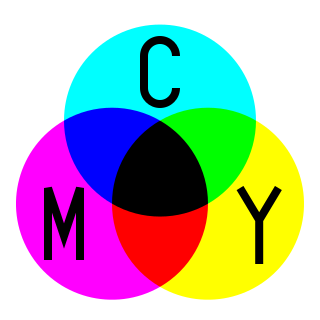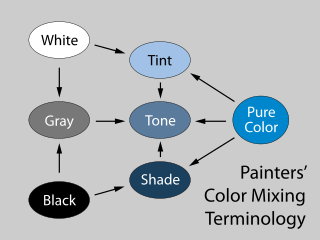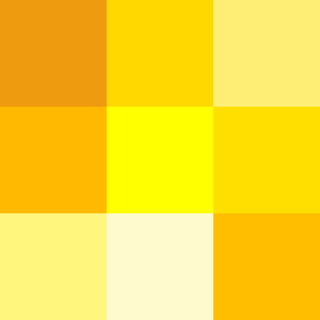
Color grading is the process of improving the appearance of an image for presentation in different environments on different devices. Various attributes of an image such as contrast, color, saturation, detail, black level, and white point may be enhanced whether for motion pictures, videos, or still images. Color grading and color correction are often used synonymously as terms for this process and can include the generation of artistic color effects through creative blending and compositing of different images. Color grading is generally now performed in a digital process either in a controlled environment such as a color suite, or in any location where a computer can be used in dim lighting.

Subtractive color or subtractive color mixing predicts the spectral power distribution of light after it passes through successive layers of partially absorbing media. This idealized model is the essential principle of how dyes and inks are used in color printing and photography where the perception of color is elicited after white light passes through microscopic "stacks" of partially absorbing media allowing some wavelengths of light to reach the eye and not others.

A smart glass or switchable glass is a glass or glazing whose light transmission properties are altered when voltage, light, or heat is applied. In general, the glass changes from transparent to translucent and vice versa, changing from letting light pass through to blocking some wavelengths of light and vice versa. Smart glass can be constructed by lamination with a smart film or switchable film, often using either glass, acrylic or polycarbonate laminates.

Day for night is a set of cinematic techniques used to simulate a night scene while filming in daylight. It is often employed when it is too difficult or expensive to actually shoot during nighttime. Because both film stocks and digital image sensors lack the sensitivity of the human eye in low light conditions, night scenes recorded in natural light, with or without moonlight, may be underexposed to the point where little or nothing is visible. This problem can be avoided by using daylight to substitute for darkness. When shooting day for night, the scene is typically underexposed in-camera or darkened during post-production, with a blue tint added. Additional effects are often used to heighten the impression of night.

In photography, toning is a method of changing the color of black-and-white photographs. In analog photography, it is a chemical process carried out on metal salt based prints such as silver prints, iron-based prints, platinum or palladium prints photographic prints. This darkroom process cannot be performed with a color photograph. The effects of this process can be emulated with software in digital photography. Sepia is considered a form of black and white or monochromatic photography.
Window film (tint) is a thin laminate film that can be installed to the interior or exterior of glass surfaces in automobiles and boats and also to the interior or exterior of glass in homes and buildings. It is usually made from polyethylene terephthalate (PET), a thermoplastic polymer resin of the polyester family, due to its clarity, tensile strength, dimensional stability, and ability to accept a variety of surface-applied or embedded treatments.
Color correction is a process used in stage lighting, photography, television, cinematography, and other disciplines, which uses color gels, or filters, to alter the overall color of the light. Typically the light color is measured on a scale known as color temperature, as well as along a green–magenta axis orthogonal to the color temperature axis.
Film tinting is the process of adding color to black-and-white film, usually by means of soaking the film in dye and staining the film emulsion. The effect is that all of the light shining through is filtered, so that what would be white light becomes light of some color.
Taint or tainted may refer to:

Color motion picture film refers both to unexposed color photographic film in a format suitable for use in a motion picture camera, and to finished motion picture film, ready for use in a projector, which bears images in color.

Tint magazine was a quarterly global zine and independent magazine published in Detroit, Michigan. Its motto "Celebrating Women of Every Color" targeted all women, the magazine typically covered issues from the voices of women of color, and often from a politically left-wing perspective.

In color theory, a tint is a mixture of a color with white, which increases lightness, while a shade is a mixture with black, which increases darkness. Both processes affect the resulting color mixture's relative saturation. A tone is produced either by mixing a color with gray, or by both tinting and shading. Mixing a color with any neutral color reduces the chroma, or colorfulness, while the hue remains unchanged.
A colour cast is a tint of a particular colour, usually unwanted, that evenly affects a photographic image in whole or in part.
Pathécolor, later renamed Pathéchrome, was an early mechanical stencil-based film tinting process for movies developed by Segundo de Chomón for Pathé in the early 20th century. Among the last feature films to use this process were the British revue film Elstree Calling (1930) and the Mexican film Robinson Crusoe (1954) by Spanish Surrealist Luis Buñuel.

Varieties of the color red may differ in hue, chroma or lightness, or in two or three of these qualities. Variations in value are also called tints and shades, a tint being a red or other hue mixed with white, a shade being mixed with black. A large selection of these various colors is shown below.

Varieties of the color yellow may differ in hue, chroma or lightness, or in two or three of these qualities. Variations in value are also called tints and shades, a tint being a yellow or other hue mixed with white, a shade being mixed with black. A large selection of these various colors is shown below.

Varieties of the color blue may differ in hue, chroma, or lightness, or in two or three of these qualities. Variations in value are also called tints and shades, a tint being a blue or other hue mixed with white, a shade being mixed with black. A large selection of these colors is shown below.

Technicolor is a series of color motion picture processes, the first version dating to 1916, and followed by improved versions over several decades.








